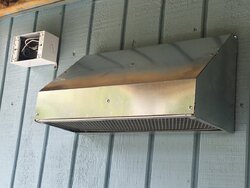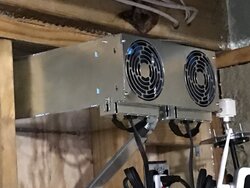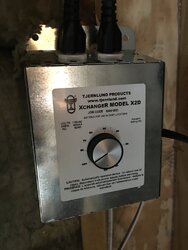Hi. I wanted to ask if anyone was having the same issues. We got our crawl space encapsulated 1 1/2 years ago. A week after, we started smelling an awful smell in the 3 rooms above it. We do not smell it in the crawl itself above the liner. The company did find hidden mold behind liner and fixed it but smell is still there. They installed a radon mitigation system with a fan and smell is still there. Got the house tested for VOC's yesterday and only got 0.1 in actual crawl. We are waiting on mold tests to come back. Any thoughts? It's really strong in one room and I've been getting sinus infections, red eyes and headaches. They are now Saying that it can't be the crawl as the smell isn't on top of the liner. But what about under the liner and it gets in through the concrete blocks? Then into the house? We do not smell it anywhere else. There is only a subfloor separating the crawl and those living spaces. No insulation. We just want it to go away...but how could it not be the crawl space? If it wasn't there before?
Smell after crawl space encapsulation
- Thread starter Jjolly
- Start date
-
Active since 1995, Hearth.com is THE place on the internet for free information and advice about wood stoves, pellet stoves and other energy saving equipment.
We strive to provide opinions, articles, discussions and history related to Hearth Products and in a more general sense, energy issues.
We promote the EFFICIENT, RESPONSIBLE, CLEAN and SAFE use of all fuels, whether renewable or fossil.
You are using an out of date browser. It may not display this or other websites correctly.
You should upgrade or use an alternative browser.
You should upgrade or use an alternative browser.
- Status
- Not open for further replies.
Lake Girl
Moderator
Is it possible that you are reacting to the material used to encapsulate? What did they use?
Was spray foam insulation applied to outer walls?
Was spray foam insulation applied to outer walls?
Last edited:
Lake Girl
Moderator
Hi! There is foam at the top of the walls above the silver foam they installed. But wouldn't that come up on the Voc reader? There's a good bit up there.Is it possible that you are reacting to the material used to encapsulate? What did they use?
Was spray foam insulation applied to outer walls?
There is foam up there but it's more of a thick caulk? The smell is more of a strong organic smell not musty.
Lake Girl
Moderator
The smell as described in the article is a "fishy" smell.
From the article linked above:
According to the U.S. Environmental Protection Agency (EPA), "exposures to [spray foam insulation (SPF)’s] key ingredient, isocyanates, and other SPF chemicals in vapors, aerosols, and dust during and after installation can cause asthma, sensitization, lung damage, other respiratory and breathing problems, and skin and eye irritation."
Since it is a two-part mix, if it is not mixed and applied properly, you can have on-going problems with the material not curing properly.
From the article linked above:
According to the U.S. Environmental Protection Agency (EPA), "exposures to [spray foam insulation (SPF)’s] key ingredient, isocyanates, and other SPF chemicals in vapors, aerosols, and dust during and after installation can cause asthma, sensitization, lung damage, other respiratory and breathing problems, and skin and eye irritation."
Since it is a two-part mix, if it is not mixed and applied properly, you can have on-going problems with the material not curing properly.
Last edited:
Yeah it's not fishy....it's more organic and kinda strong like a chemical odor. But it's not in the actual crWl space. I've smelled it under the liner but not on top...The smell as described in the article is a "fishy" smell.
peakbagger
Minister of Fire
I hope you aren't relying on the installer or anyone associated with them to diagnose this situation?. With symptoms like you describe, you need an independent to figure out what is going on. There are usually hygiene consultants used by industrial firms in most areas. It may take some calling around but you need to get a air test and figure out where the contaminants are coming from as there can be long term health issues from what appears to be misapplication of chemicals. Foam got a real bed rep years ago by installers who cut corners. I don't know the current formulations but in the older foam systems there was one part that was expensive and one part that was less expensive. Shady installers would change the ratio in the pumps to spray out more of the cheap product. It looked like foam but it would offgas some very nasty products for years driving folks out of homes.
Hi. The company is trying to help...they brought In a biologist to test air we are waiting on results but they are still saying it's not the crawl. Because we don't smell it in the actual crawl just the living space? But it's knky in the 3 rooms above the crawl and appeared right after encap. We just bought this house a month before we did the encap. And there were zero smells. But it was built in 1976...so it's older.I hope you aren't relying on the installer or anyone associated with them to diagnose this situation?. With symptoms like you describe, you need an independent to figure out what is going on. There are usually hygiene consultants used by industrial firms in most areas. It may take some calling around but you need to get a air test and figure out where the contaminants are coming from as there can be long term health issues from what appears to be misapplication of chemicals. Foam got a real bed rep years ago by installers who cut corners. I don't know the current formulations but in the older foam systems there was one part that was expensive and one part that was less expensive. Shady installers would change the ratio in the pumps to spray out more of the cheap product. It looked like foam but it would offgas some very nasty products for years driving folks out of homes.
Lake Girl
Moderator
Moisture problems in the crawl space prior to encapsulation? I would suspect an independent consultant would be more beneficial...
What about drainage around the exterior of the foundation? Possible there is moisture build-up along interior walls of crawl space?
What about drainage around the exterior of the foundation? Possible there is moisture build-up along interior walls of crawl space?
Last edited:
Moisture levels are around 45% which they say is perfect for the crawl. We also have a moisture reader in our house. There was no water intrusion before encap only a leaky outside faucet which was fixed with well Installed outside. I feel like we covered everything except for the soil u see watch the liner.Moisture problems in the crawl space prior to encapsulation? I would suspect an independent consultant would be more beneficial...
What about drainage around the exterior of the foundation? Possible there is moisture build-up along interior walls of crawl space?
Lake Girl
Moderator
I would find out what spray foam brand they utilized and then research that.
While it will cost you, I would look into an independent consultant who likely has more experience with potential problems.
Edit: https://www.thumbtack.com/nc/charlotte/indoor-air-quality-testing-companies/
http://www.cdaenvironmental.com/
Thomas register entries:
http://www.thomasnet.com/north-carolina/air-quality-testing-services-84841998-1.html
While it will cost you, I would look into an independent consultant who likely has more experience with potential problems.
Edit: https://www.thumbtack.com/nc/charlotte/indoor-air-quality-testing-companies/
http://www.cdaenvironmental.com/
Thomas register entries:
http://www.thomasnet.com/north-carolina/air-quality-testing-services-84841998-1.html
Last edited:
Hi, there is no known moisture at the crawl before encap? Just the small leak. No one found any standing water. I am going to try to find my own independent tester to make sure their results are correct.Moisture problems in the crawl space prior to encapsulation? I would suspect an independent consultant would be more beneficial...
What about drainage around the exterior of the foundation? Possible there is moisture build-up along interior walls of crawl space?
Hi it did not? You think that could be the problem? Even if we smell nothing in crawl?Did the testing include formaldehyde emissions?
Very hard to tell without actually smelling it, but some of the symptoms experienced match. Did nothing else change, like new carpet or furniture?
semipro
Minister of Fire
Is there dedicated ventilation ducts/openings between the encapsulated crawl space and conditioned living area?
My understanding is that this is required to prevent mold growth in the crawl space.
My understanding is that this is required to prevent mold growth in the crawl space.
Hi no new furniture. We redid hvac system after the encap and painted but all of that was after. Just moved into the house a month before we did encap.Very hard to tell without actually smelling it, but some of the symptoms experienced match. Did nothing else change, like new carpet or furniture?
Hi we do have the radon mitigation system but it's not working. Was thinking to put a fan down there and see what it does?Is there any way to ventilate the crawl space and see if that makes any difference?
Hi no there is not? Our crawl space is also attaches to our basement that is conditioned. But there is a door separating them. Everything in the crawl space is closed and there is no ventilation? Should there be? No one has ever said that.Is there dedicated ventilation ducts/openings between the encapsulated crawl space and conditioned living area?
My understanding is that this is required to prevent mold growth in the crawl space.
semipro
Minister of Fire
That's my understanding. Read at green building advisor , fine homebuilding, or building science.Hi no there is not? Our crawl space is also attaches to our basement that is conditioned. But there is a door separating them. Everything in the crawl space is closed and there is no ventilation? Should there be? No one has ever said that.
Edit: http://www.energyvanguard.com/crawl-space-encapsulation-features
Last edited:
Lake Girl
Moderator
Catchy title and a good question. Nasty chemicals used. http://www.treehugger.com/green-arc...n-something-so-toxic-be-considered-green.html
Jjolly, what brand spray foam was used in the crawlspace?
Jjolly, what brand spray foam was used in the crawlspace?
Hi thanks will check it out!Catchy title and a good question. Nasty chemicals used. http://www.treehugger.com/green-arc...n-something-so-toxic-be-considered-green.html
Jjolly, what brand spray foam was used in the crawlspace?
This is the best way to ventilate the crawl space!Is there any way to ventilate the crawl space and see if that makes any difference?
I got one for my new workshop, works great!
http://tjernlund.com/xchanger_basement_fan.htm
See my pics below:
Just set the humidity level on the Humistat and forget it!
Attachments
- Status
- Not open for further replies.
Similar threads
- Replies
- 9
- Views
- 2K
- Replies
- 4
- Views
- 2K




